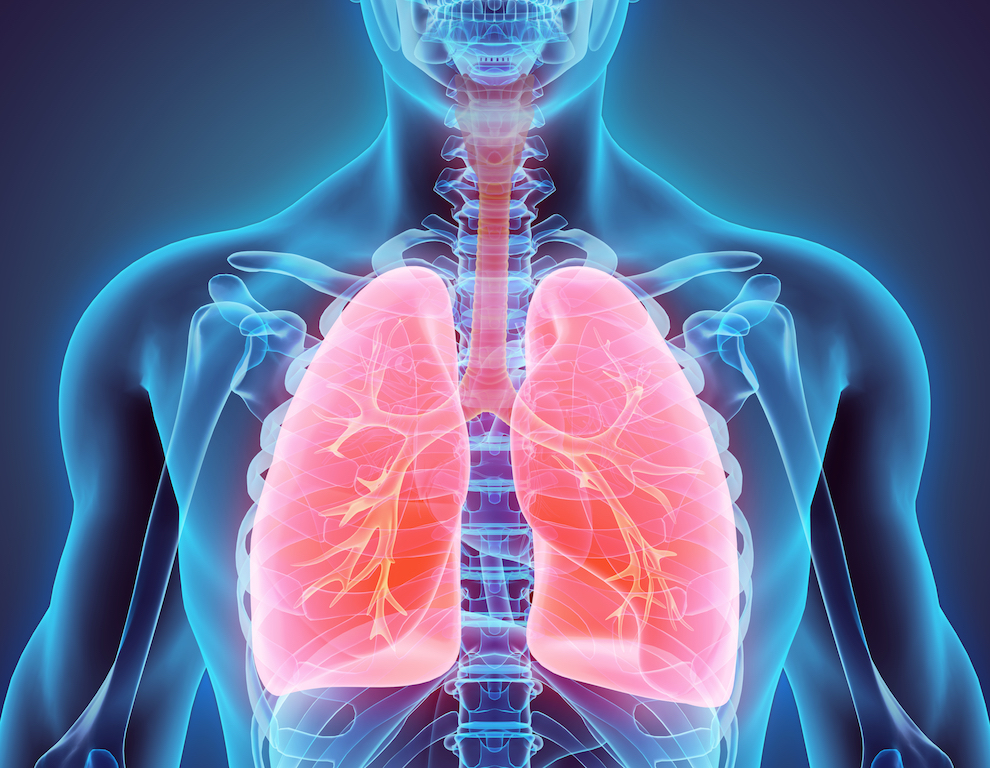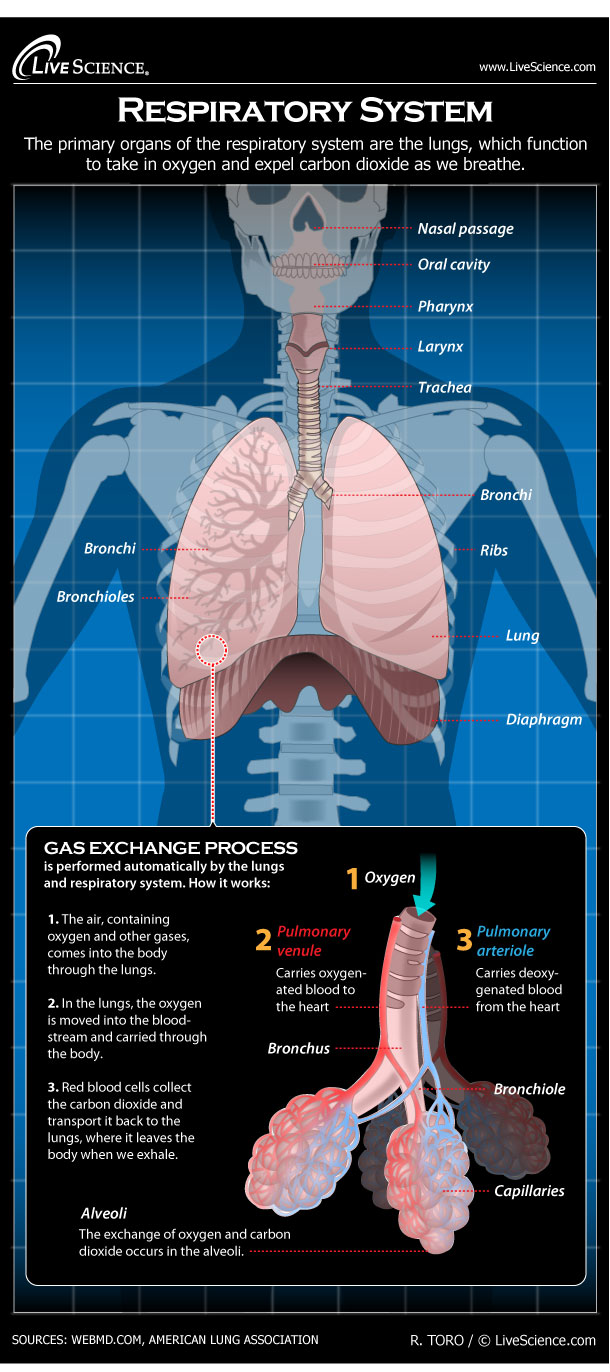Chapter 13 The Respiratory System
Respiratory organisation: Facts, function and diseases

The human respiratory system is a network of organs responsible for taking in oxygen and expelling carbon dioxide. Its principal organs are the lungs, which carry out this exchange of gases as we breathe.
The lungs work with the circulatory organization to pump oxygen-rich blood to all cells in the trunk. The blood and then collects carbon dioxide and other waste products and transports them back to the lungs, where the waste products are pumped out of the body when we exhale, according to the American Lung Clan.
The human body needs oxygen to sustain itself. After only most five minutes without oxygen, brain cells begin dying, according to the National Institute of Neurological Disorders and Stroke, which can atomic number 82 to brain damage and ultimately death.
Related: Gasp! xi surprising facts about the respiratory system
In humans, the average animate, or respiratory rate, mostly depends on age. A newborn's normal animate rate is nearly xl to 60 times each minute and may slow to 30 to 40 times per minute when the baby is sleeping, co-ordinate to Stanford Children's Health. The average resting respiratory rate for adults is 12 to 16 breaths per infinitesimal, and up to twoscore to threescore breaths per minute during practise, according to the European Respiratory Society.
Parts of the respiratory organisation
There are many components to the respiratory organisation. They include:
- Nose
- Oral cavity
- Throat (pharynx)
- Voice box (larynx)
- Windpipe (trachea)
- Big airways (bronchi)
- Small-scale airways (bronchioles)
- Lungs
- Diaphragm
As we breathe, oxygen enters the nose or mouth and passes the sinuses, which are hollow spaces in the skull that help regulate the temperature and humidity of the air we breathe.
From the sinuses, air passes through the trachea, also called the windpipe, and into the bronchial tubes, which are the two tubes that carry air into each lung (each one is called a bronchus). The bronchial tubes are lined with tiny hairs chosen cilia that motility dorsum and forth, carrying fungus up and out. Mucus is a gluey fluid that collects dust, germs and other matter that has invaded the lungs and is what we miscarry when nosotros sneeze and cough.
Related: Where does all my snot come from?
The bronchial tubes dissever up once more to behave air into the lobes of each lung. The right lung has 3 lobes while the left lung has merely two, to accommodate room for the centre, co-ordinate to the American Lung Association. The lobes are filled with modest, spongy sacs called alveoli, which is where the exchange of oxygen and carbon dioxide occurs.


The alveolar walls are extremely thin (about 0.2 micrometers) and are equanimous of a unmarried layer of tissues chosen epithelial cells and tiny claret vessels called pulmonary capillaries. Claret in the capillaries picks upwards oxygen and drops off carbon dioxide. The oxygenated blood then makes its way to the pulmonary veins. These four veins, 2 from each lung, carry oxygen-rich blood to the left side of the middle, where it is pumped to all parts of the trunk. The carbon dioxide the claret left behind moves into the alveoli and gets expelled in our exhaled jiff.
The diaphragm, a dome-shaped muscle at the bottom of the lungs, controls breathing and separates the chest cavity from the intestinal crenel. When air gets taken in, the diaphragm tightens and moves downward, making more than infinite for the lungs to fill with air and expand, according to the National Heart, Lung and Claret Found. During exhalation, the diaphragm expands and compresses the lungs, forcing air out.
Respiratory system diseases
Diseases and conditions of the respiratory system fall into two categories: Infections, such as influenza, bacterial pneumonia and enterovirus respiratory virus, and chronic diseases, such as asthma and chronic obstructive pulmonary affliction (COPD).
Viral infections
Non much can be done for viral infections only to let them run their course, according to Dr. Neal Chaisson, who practices pulmonary medicine at the Cleveland Clinic. "Antibiotics are not effective in treating viruses and the best thing to do is just rest," he said.
For most healthy individuals, the well-nigh common respiratory disquiet they may face is an infection, said Dr. Matthew Exline, a pulmonologist and critical care expert at The Ohio State University Wexner Medical Center. A coughing is the kickoff symptom, perhaps accompanied by a fever.
Related: The gross science of a cough and a sneeze
"All the same, a coughing can be a sign of chronic respiratory weather such as asthma, chronic bronchitis or emphysema," he said. "In chronic lung disease, most respiratory diseases present with shortness of breath, initially with exertion, such as walking a significant distance or climbing several flights of stairs."

Asthma
Asthma is a chronic inflammation of the lung airways that causes coughing, wheezing, breast tightness or shortness of jiff, according to Tonya Winders, president of the Allergy & Asthma Network. These signs and symptoms may be worse when a person is exposed to their triggers, which tin include air pollution, tobacco fume, factory fumes, cleaning solvents, infections, pollens, foods, cold air, exercise, chemicals and medications. Exercise can also induce asthma. More than 25 1000000 people (or 1 in 13 adults and 1 in 12 children) in the United states of america take asthma, according to the Centers for Disease Command and Prevention (CDC).
For some people, asthma is a mild irritation, merely for others it can exist a life-threatening status, according to the Mayo Clinic. Asthma cannot be cured, just its symptoms can be managed. Early identification and handling tin prevent long-term impairment and stop asthma from getting worse over time.
Chronic obstructive pulmonary disease (COPD)
COPD is a chronic and progressive disease in which the air flow in and out of the lungs decreases, making it harder to breathe. COPD is a combination of chronic bronchitis (inflammation of the bronchial tubes) and emphysema (damaged alveoli), co-ordinate to the Mayo Clinic. Smoking is the leading crusade of COPD.
Over time, the airways of people with COPD become inflamed and thicken, making it harder to become rid of waste material carbon dioxide, according to the American Lung Association. As the disease progresses, patients experience a shortness of jiff, and it can limit activity. More than 16 million Americans are afflicted by COPD, co-ordinate to the CDC. COPD has no cure, but it tin exist treated.

(opens in new tab)
Lung cancer
Lung cancer is often associated with smoking, but the affliction can bear on nonsmokers as well. It is the 2nd most mutual cancer for both men and women, outranked past prostate and breast cancers, respectively.
The American Cancer Lodge (ACS) estimates that in 2021, there will exist about 235,760 new cases of lung cancer (119,100 in men and 116,660 in women) and around 131,880 deaths from lung cancer (69,410 in men and 62,470 in women) in the Us. Notwithstanding, the number of lung cancer deaths has been on a downward slope in contempo years due to advances in treatment and early on detection.Almost people diagnosed with lung cancer are older than 65, and the average age of people diagnosed with lung cancer is 70, according to ACS.
There are ii different types of lung cancer, which is cancer that originates in the lungs every bit opposed to cancer that spreads to the lungs –– small cell lung cancer and non-modest cell lung cancer, according to the Mayo Dispensary. Small jail cell lung cancer is most commonly found in heavy smokers, and is less mutual than non-small cell lung cancer.
The main symptoms for lung cancer are shortness of jiff, pain, cough upward blood, and fluid in the lungs. A doctor diagnoses lung cancer past performing imaging tests, such as a CT scan; testing coughed-up sputum; and a lung biopsy.
Handling is based on the extent of the lung cancer, and whether it has spread to other parts of the body. Treatments range from surgery, chemotherapy and radiation therapy, through to palliative care.
Additional resources
- Read more about the anatomy of the respiratory organisation from the University of Rochester Medical Center.
- Spotter "Encounter the Lungs," from the Khan Academy.
- Cheque out this useful diagram of the respiratory organization, from The Lung Association.
This article was updated on July xvi, 2021 by Live Science Contributor Sarah Wild.
Chapter 13 The Respiratory System,
Source: https://www.livescience.com/22616-respiratory-system.html
Posted by: lohmanmrsed2001.blogspot.com


0 Response to "Chapter 13 The Respiratory System"
Post a Comment